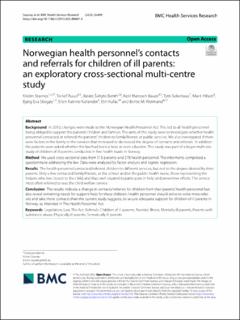| dc.contributor.author | Stavnes, Kristin Anne | |
| dc.contributor.author | Ruud, Torleif | |
| dc.contributor.author | Saltyte Benth, Jurate | |
| dc.contributor.author | Hanssen-Bauer, Ketil | |
| dc.contributor.author | Solantaus, Tytti | |
| dc.contributor.author | Hilsen, Marit | |
| dc.contributor.author | Skogøy, Bjørg Eva | |
| dc.contributor.author | Kallander, Ellen Katrine | |
| dc.contributor.author | Kufås, Elin | |
| dc.contributor.author | Weimand, Bente Margrethe | |
| dc.date.accessioned | 2023-07-26T11:46:21Z | |
| dc.date.available | 2023-07-26T11:46:21Z | |
| dc.date.created | 2023-06-18T21:52:10Z | |
| dc.date.issued | 2023 | |
| dc.identifier.citation | Stavnes, K., Ruud, T., Benth, J. Š., Hanssen-Bauer, K., Solantaus, T., Hilsen, M., Skogøy, B. E., Kallander, E. K., Kufås, E. & Weimand, B. M. (2023). Norwegian health personnel’s contacts and referrals for children of ill parents: an exploratory cross-sectional multi-centre study. BMC Health Services Research, 23, Artikkel 649. | en_US |
| dc.identifier.issn | 1472-6963 | |
| dc.identifier.uri | https://hdl.handle.net/11250/3081433 | |
| dc.description.abstract | Background: In 2010, changes were made to the Norwegian Health Personnel Act. This led to all health personnel being obliged to support the patients’ children and families. The aims of this study were to investigate whether health personnel contacted or referred the patients’ children to family/friends or public services. We also investigated if there were factors in the family or the services that increased or decreased the degree of contacts and referrals. In addition the patients were asked whether the law had been a help or even a burden. This study was part of a larger multi-site study of children of ill parents conducted in five health trusts in Norway.
Method: We used cross-sectional data from 518 patients and 278 health personnel. The informants completed a questionnaire addressing the law. Data were analyzed by factor analysis and logistic regression.
Results: The health personnel contacted/referred children to different services, but not to the degree desired by their parents. Only a few contacted family/friends, or the school and/or the public health nurse, those representing the helpers who live closest to the child, and thus well situated to participate in help and preventive efforts. The service most often referred to was the child welfare service.
Conclusion: The results indicate a change in contacts/referrals for children from their parents’ health personnel but also reveal remaining needs for support/help for these children. Health personnel should strive to write more referrals and take more contacts than the current study suggests, to secure adequate support for children of ill parents in Norway, as intended in The Health Personnel Act. | en_US |
| dc.language.iso | eng | en_US |
| dc.rights | Navngivelse 4.0 Internasjonal | * |
| dc.rights.uri | http://creativecommons.org/licenses/by/4.0/deed.no | * |
| dc.title | Norwegian health personnel’s contacts and referrals for children of ill parents: an exploratory cross-sectional multi-centre study | en_US |
| dc.type | Peer reviewed | en_US |
| dc.type | Journal article | en_US |
| dc.description.version | publishedVersion | en_US |
| dc.rights.holder | © The Author(s) 2023. | en_US |
| dc.source.volume | 23 | en_US |
| dc.source.journal | BMC Health Services Research | en_US |
| dc.identifier.doi | https://doi.org/10.1186/s12913-023-09607-0 | |
| dc.identifier.cristin | 2155543 | |
| dc.relation.project | Norges forskningsråd: 213477 | en_US |
| dc.source.articlenumber | 649 | en_US |
| cristin.ispublished | true | |
| cristin.fulltext | original | |
| cristin.qualitycode | 2 | |

